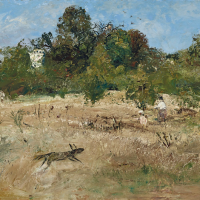17. ARTHUR BOYD

Figures with a Dog represents a significant and highly accomplished painting from Arthur Boyds early years in England. Following his relocation from Australia in November 1959, a period of significant consolidation and change occurred in Boyds art. He had left behind the familiarity of Australia and was transitioning toward a more nuanced response to the muted light, heavier atmosphere, and the feel of a new domain. Boyd looked for ways to extend his range and subject matter to become broader and even more expansive in its visual appeal.
Arthur Boyd had gone to England for an anticipated short stay initially allowing enough time to see some of the great art and artists of Europe. It was his first overseas experience, and he was looking forward to following up contacts and, hopefully, organising a showing of his work. Six months became much longer, as Arthur and his family (wife Yvonne, and children Polly, Jamie, and Lucy) made their base in England for the next twenty years.
Part of the attraction for Boyd was that he found a place to live that was a welcome and relatively quiet sanctuary to do his work, as well as being close to the hurly burly of the London art world. Hampstead Heath, an extensive wild park of woodland and meadows, was less than four miles from the city centre. This seemingly ideal location had a long history of attracting artists of all nationalities and persuasions. Other Australian artists also gravitated there including Boyds brother-in-law, the painter John Perceval, his wife Mary (Arthurs younger sister) and their quartet of young children: Matthew, Tessa, Celia, and Alice. The Percevals settled first with Arthur and Yvonne Boyd in Hampstead Heath, before finding their own house close by in Highgate. With such a convivial setting and extended family cluster, it is appropriate that both Boyd and Perceval would focus their attention on subjects that included people at leisure in the woodlands, children playing hide and seek in the surrounding thickets and the frolicking of dogs in the fields.
Three paintings selected from the late 1950s and early 1960s, including our work, reveal the subtle interchanges and transitions in Boyds landscape painting at the time. Shelly Beach 1958, a picture from the collection of the National Gallery of Victoria, is a wonderful exemplar of how Boyd extemporised the landscape to create the sensation of a relaxed, harmonious setting. Various figures and groups of people wade in the shallows and cavort along the calm foreshore of Port Phillip Bay. The colours and the measured horizontal bands of sand, water, and sky contribute to a sense of order, as well as creating a prescient feeling of luminosity and peacefulness. A Mother, Child and Dog on Hampstead Heath 1963, is another major work by Boyd that continues the familial domesticity in the landscape theme. This time it is orchestrated in a recognisably English setting. In this painting, the figures are no longer placed on the surface of the picture, as in Shelly Beach, but are now fully integrated into it. This aspect became a signature motif of Boyds English works, including in his more highly charged and overtly symbolic Lovers and Brides series.
Figures With a Dog sits happily in its own space, between the warming luminosity of the Australian work and the entangled, dense mass of his English figure and landscape paintings. In this engaging and highly tactile painting Boyd adopts a mid-range view. He steps back slightly to provide a balanced and centred composition that runs in bands of brown, green and blue. The gambolling dog animates the scene and creates a visual link, running in a circular motion to connect the mother and child on the right, the partially obscured residence in the background, and the father bending attentively to the needs of a child. It is as if the dogs spirited behaviour locks the surrounding figures into a joyous spatial dance.
The inclusion of a black dog is no coincidence. In 1961, Arthur Boyd travelled to Paris, with Barry Humphries and Charles Blackman, to see the Goya exhibition at the Muse Jacquemart-Andr, a distinguished private museum. Goyas famous painting The Dog 18191823, now in the Museo del Prado, Madrid, also captivated Boyd. However, in Figures with a Dog, its presence points not to a morbid fascination with death, as in the Goya painting, but to the presence of joy and memories of their much-loved family pet. The dog named Peter often appears in Boyds paintings and drawings. Along with the corresponding application of paint, dogs are a major contributor to the vitality of his painting. Boyd works and reworks the wet-on-wet surface vigorously but with a fine sense of control. The flicks and dribbles of paint and the use of the pointy end of a brush incised directly into the paint animate Figures with a Dog and give it energy and life.
Rodney James
Rodney James is an independent art consultant who specialises in valuations, collection management, exhibitions, research and writing, and strategic planning for art galleries and museums.